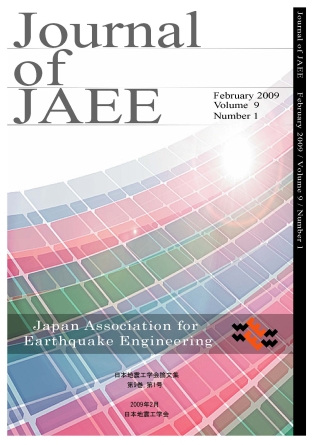All issues

Volume 13 (2013)
- Issue 5 Pages 5_1-
- Issue 4 Pages 4_1-
- Issue 3 Pages 3_1-
- Issue 2 Pages 2_1-
- Issue 1 Pages 1-
Volume 13, Issue 4
Displaying 1-5 of 5 articles from this issue
- |<
- <
- 1
- >
- >|
Technical Papers
-
Asako IWAKI, Hiroyuki FUJIWARA2013 Volume 13 Issue 4 Pages 4_1-4_18
Published: 2013
Released on J-STAGE: August 27, 2013
JOURNAL FREE ACCESSBroadband ground motion computations of scenario earthquakes are often based on hybrid methods that are combinations of deterministic approach in lower frequency (LF) band and stochastic approach in higher frequency (HF) band. It is difficult to keep consistency between LF and HF wave fields that are generated through different data and method in such hybrid approaches. In this paper, we focus on the relationship of ground motion characteristics between LF and HF bands and present a new method to synthesize HF ground motion using information extracted from LF ground motion, which we assume can be computed by a numerical method up to approximately 1 Hz. The relationship of envelopes characteristics among different frequency bands are investigated by taking their ratios at strong motion observation sites in Kanto area, Japan. We showed that HF ground motion can be appropriately synthesized by multiplying the LF ground motion by the envelope ratio functions.View full abstractDownload PDF (3192K) -
Makoto Tamura, Yu Tabayashi, Frank Hiroshi Ling, Kiyotake Ajima, Nobu ...2013 Volume 13 Issue 4 Pages 4_19-4_37
Published: 2013
Released on J-STAGE: August 27, 2013
JOURNAL FREE ACCESSThis study characterizes the evacuation behavior in Ibaraki Prefecture in the aftermath of the Great East Japan Earthquake(or 2011 off the Pacific coast of Tohoku Earthquake) and tsunamis, using geographic information as well as questionnaire and interview surveys. We analyzed the dependency of the starting time of evacuation on several factors, including awareness of evacuation warnings, understanding of anticipated tsunami inundation areas and hazard maps, and the distance from anticipated inundation areas. It is found that those who knew of evacuation sites, were aware of hazard maps and/or anticipated inundation areas map, and lived in inundated area tended to evacuate earlier. On the other hand, many residents delayed their evacuation because they chose to go home and take care of their family first. To improve future response to likely threats, the evacuation behavior and local disaster management plans must be reviewed based on theknowledge gained from this disaster.View full abstractDownload PDF (2516K) -
Yoshiki IKEDA, Yoshiaki HISADA2013 Volume 13 Issue 4 Pages 4_38-4_54
Published: 2013
Released on J-STAGE: August 27, 2013
JOURNAL FREE ACCESSThe proposed method estimates earthquake responses on all floors in a building by utilizing observation records on some restricted floors. The modal properties are identified by a single-input-multi-output ARX model. Each modal shape is assumed to be a sinusoidal function with two parameters, and the parameters are determined by system identification results. The responses on all floors are evaluated by both the modal shape functions and the corresponding modal responses at the appointed observation floors. The application to the 2011 off the Pacific coast of Tohoku Earthquake observation in a high-rise building shows high effectiveness in structural damage detection.View full abstractDownload PDF (720K)
Technical Reports
-
Takashi AKAZAWA, Masayuki ARAKI, Kiyoshi TAKANO, Sumio SAWADA, Yasuhir ...2013 Volume 13 Issue 4 Pages 4_55-4_67
Published: 2013
Released on J-STAGE: August 27, 2013
JOURNAL FREE ACCESSWe developed a new low-cost data logger KS-002D for the CEORKA strong-motion network. The data logger can send the observed continuous data in real-time through Internet connection and back-up the same data in large-capacity memory card inserted into the data logger. These features solve the significant problems of the previous CEORKA's system. The new data loggers were installed progressively in CEORKA's stations from March 2009 and the full-scale operation of the new observation system started in August 2011. The new system realizes real-time continuous observation, while maintaining the previous observation system in the same time.The accuracy of the new data logger were verified by comparison with several event and microtremor records obtained by the old data logger and the strong motion seismograph that can measure microtremors. The results for event records show the same or better accuracy obtained by the old data logger. On the other hand, microtremor records show somewhat lower accuracy in high-frequency range at the hard bedrock station, although accuracy of other records is the same as obtained by the strong motion seismograph that can measure microtremors. Above verification results show that the new data logger can obtain broadband and high-accuracy data ranging from strong motions to microtremors.View full abstractDownload PDF (3885K) -
Masaharu SUGAHARA, Tomiichi UETAKE2013 Volume 13 Issue 4 Pages 4_68-4_84
Published: 2013
Released on J-STAGE: August 27, 2013
JOURNAL FREE ACCESSWe often face the large scattering of peak accelerations in the statistical analyses of strong ground motion. The ratios of source spectra were evaluated from the acceleration records observed at the same stations for some earthquake pairs whose epicenters were very close so as to cancel the effects of a path and a site. The stress drops of these events were estimated by comparing the observed source spectral ratios and theoretical ones. The stress-drop affects the short period spectral levels. It is effective for reducing the variance of estimated peak accelerations of ground motions to consider the difference of stress drop in the attenuation relations.View full abstractDownload PDF (458K)
- |<
- <
- 1
- >
- >|